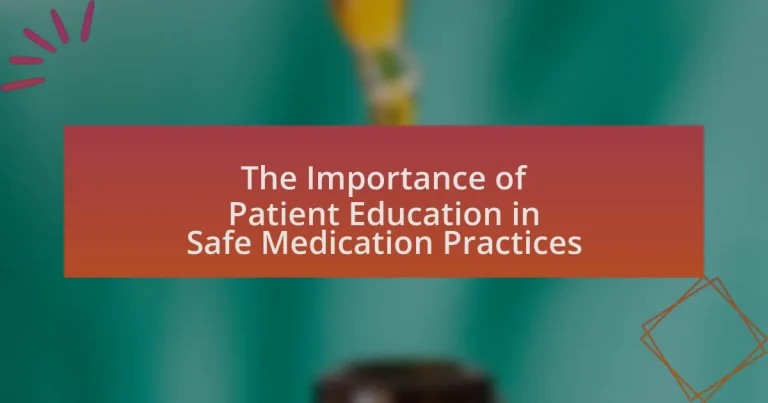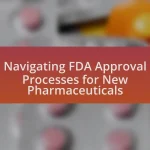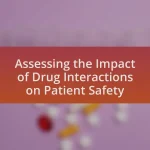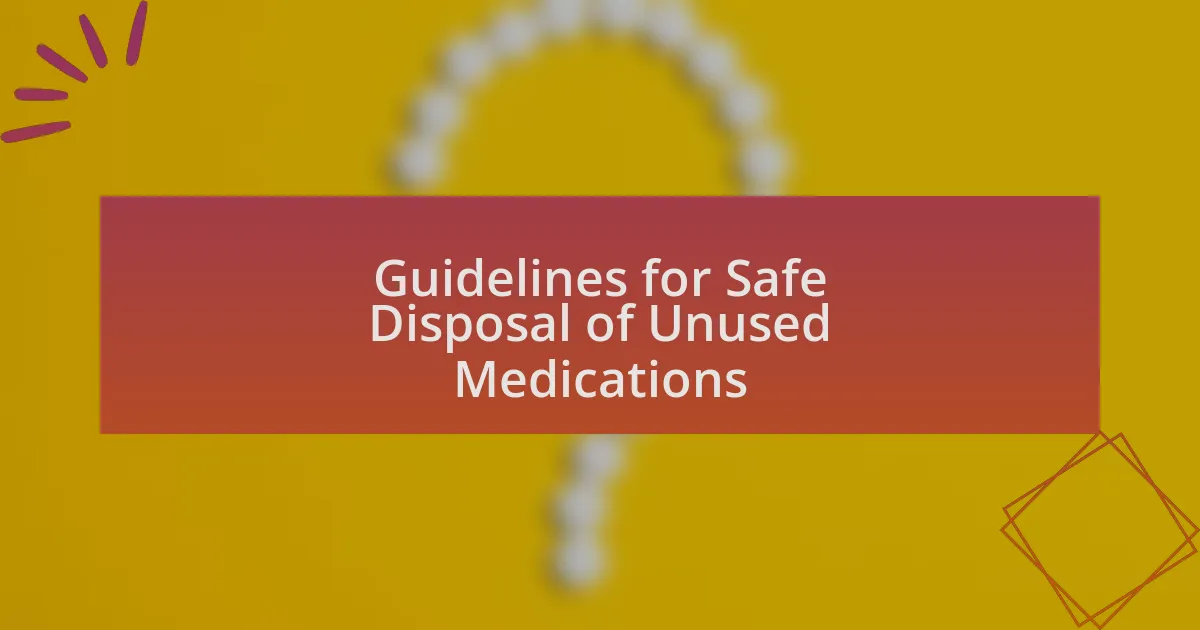Patient education is a critical component of safe medication practices, significantly impacting adherence and reducing medication errors. Educated patients are more likely to understand their medications, recognize side effects, and communicate effectively with healthcare providers, leading to improved health outcomes. The article explores the importance of patient education in medication safety, the risks associated with inadequate education, and the role of healthcare providers in delivering effective information. It also discusses strategies for enhancing patient understanding, the barriers to effective education, and best practices for ensuring safe medication use.
What is the Importance of Patient Education in Safe Medication Practices?
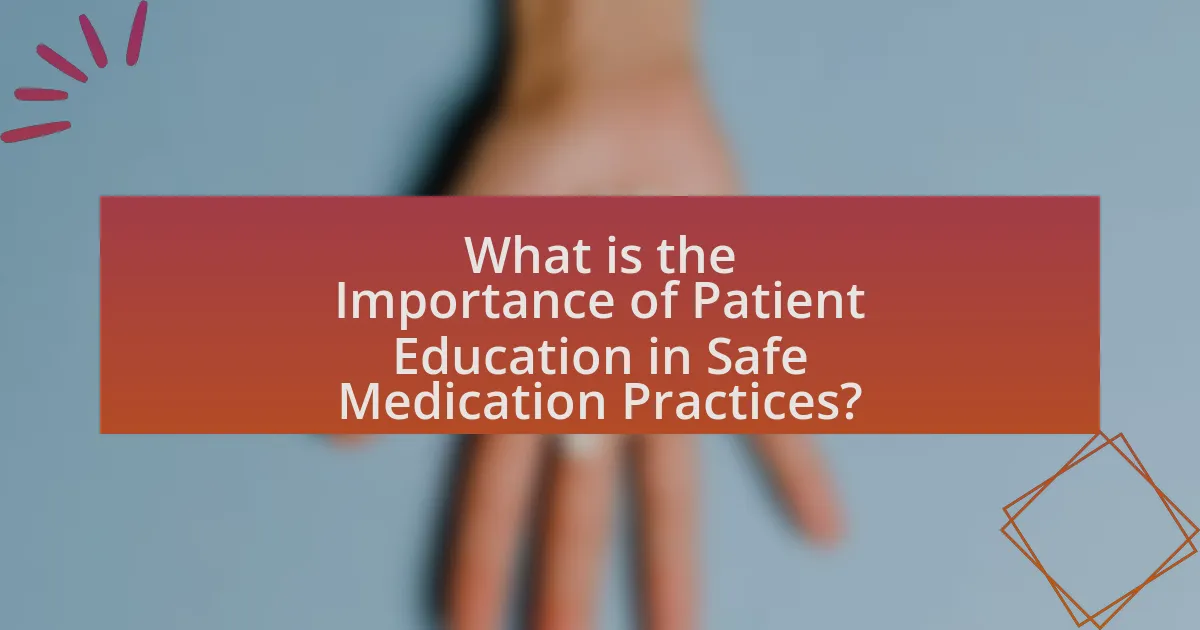
Patient education is crucial in safe medication practices as it empowers individuals to understand their medications, leading to improved adherence and reduced medication errors. Educated patients are more likely to follow prescribed regimens accurately, recognize potential side effects, and communicate effectively with healthcare providers. Research indicates that effective patient education can decrease hospital readmission rates by up to 30%, highlighting its role in enhancing patient safety and health outcomes.
Why is patient education crucial for medication safety?
Patient education is crucial for medication safety because it empowers individuals to understand their medications, including proper usage, potential side effects, and interactions. When patients are informed, they are more likely to adhere to prescribed regimens, reducing the risk of medication errors. Studies indicate that effective patient education can decrease adverse drug events by up to 50%, highlighting its role in enhancing safety and improving health outcomes.
What are the potential risks of inadequate patient education?
Inadequate patient education poses significant risks, including medication errors, non-adherence to treatment plans, and adverse health outcomes. Patients lacking proper understanding of their medications may mismanage dosages or fail to recognize side effects, leading to complications. Research indicates that approximately 50% of patients do not take their medications as prescribed, often due to misunderstandings about their treatment, which can result in hospitalizations and increased healthcare costs. Furthermore, inadequate education can contribute to patients not recognizing when to seek medical help, exacerbating their conditions.
How does patient education impact medication adherence?
Patient education significantly enhances medication adherence by improving patients’ understanding of their treatment regimens. When patients are well-informed about their medications, including their purpose, dosage, and potential side effects, they are more likely to follow prescribed instructions. Research indicates that effective patient education can increase adherence rates by 50% or more, as evidenced by a study published in the Journal of Managed Care & Specialty Pharmacy, which found that patients who received comprehensive education were more likely to take their medications as directed. This correlation underscores the critical role of patient education in promoting safe medication practices and improving health outcomes.
What role do healthcare providers play in patient education?
Healthcare providers play a crucial role in patient education by delivering essential information about medications, treatment plans, and health management strategies. They ensure that patients understand their conditions, the importance of adherence to prescribed therapies, and the potential side effects of medications. Research indicates that effective patient education can lead to improved health outcomes, as patients who are well-informed are more likely to follow treatment regimens and engage in self-care practices. For instance, a study published in the Journal of the American Medical Association found that patients who received comprehensive medication counseling from healthcare providers experienced a 30% reduction in medication errors. This underscores the significant impact healthcare providers have in fostering safe medication practices through education.
How can healthcare providers effectively communicate medication information?
Healthcare providers can effectively communicate medication information by utilizing clear, concise language and employing teach-back methods to ensure patient understanding. Clear language minimizes confusion and enhances comprehension, while teach-back methods involve asking patients to repeat the information in their own words, confirming their understanding. Research indicates that effective communication strategies, such as these, can significantly reduce medication errors and improve adherence rates, as evidenced by a study published in the Journal of Patient Safety, which found that patients who received clear instructions were 30% more likely to adhere to their medication regimens.
What strategies can providers use to enhance patient understanding?
Providers can enhance patient understanding by utilizing clear communication techniques, such as using plain language, visual aids, and teach-back methods. Clear communication ensures that patients comprehend medical information without confusion, which is crucial for safe medication practices. For instance, studies show that using plain language reduces misunderstandings and increases patient adherence to medication regimens. Additionally, incorporating visual aids, like diagrams or charts, can help illustrate complex concepts, making them more accessible. The teach-back method, where providers ask patients to explain back what they have learned, confirms understanding and allows for clarification of any misconceptions. These strategies collectively improve patient comprehension and contribute to safer medication practices.
What are the key components of effective patient education?
The key components of effective patient education include clear communication, tailored information, active participation, and ongoing support. Clear communication ensures that patients understand their conditions and treatment options, while tailored information addresses individual needs and literacy levels. Active participation encourages patients to engage in their care, fostering a sense of ownership and responsibility. Ongoing support provides patients with resources and follow-up to reinforce learning and address any concerns. Research indicates that effective patient education can lead to improved health outcomes, as evidenced by a study published in the Journal of Patient Safety, which found that patients who received comprehensive education were 30% more likely to adhere to medication regimens.
What types of information should be included in patient education materials?
Patient education materials should include information on medication usage, potential side effects, dosage instructions, and the importance of adherence to prescribed regimens. These components are essential for ensuring that patients understand how to take their medications safely and effectively. Research indicates that clear communication about medication can significantly reduce the risk of errors and improve health outcomes, as evidenced by a study published in the Journal of Patient Safety, which found that effective patient education reduced medication errors by 50%.
How can technology be utilized to improve patient education?
Technology can be utilized to improve patient education by providing interactive platforms that enhance understanding of medication practices. For instance, mobile applications can deliver personalized medication reminders, educational videos, and interactive quizzes that engage patients and reinforce learning. Research indicates that patients using digital tools for education report higher adherence to medication regimens, as evidenced by a study published in the Journal of Medical Internet Research, which found that 70% of participants using a mobile health app improved their medication compliance. This demonstrates that technology not only facilitates access to information but also actively engages patients in their healthcare, leading to safer medication practices.
How can we transition from general education to specific practices?
To transition from general education to specific practices in the context of patient education for safe medication practices, healthcare providers must implement targeted training programs that focus on the unique needs of patients. This involves developing educational materials that address specific medication regimens, potential side effects, and adherence strategies tailored to individual patient profiles. Research indicates that personalized education significantly improves patient understanding and compliance, as evidenced by a study published in the Journal of Patient Safety, which found that tailored interventions led to a 30% increase in medication adherence among patients with chronic conditions. By utilizing patient-specific data and feedback, healthcare professionals can effectively bridge the gap between general knowledge and practical application, ensuring safer medication practices.
What are the barriers to effective patient education in medication practices?
Barriers to effective patient education in medication practices include communication issues, health literacy deficits, and time constraints. Communication issues arise when healthcare providers fail to convey information clearly, leading to misunderstandings about medication use. Health literacy deficits affect patients’ ability to comprehend medical instructions, which can result in improper medication adherence. Time constraints in clinical settings limit the opportunity for thorough patient education, often resulting in incomplete information being provided. According to a study published in the Journal of Health Communication, nearly 90 million adults in the U.S. struggle with health literacy, which significantly impacts their ability to manage medications effectively.
What specific techniques can enhance patient education for safe medication practices?
Specific techniques that can enhance patient education for safe medication practices include the use of teach-back methods, personalized medication schedules, and interactive educational materials. Teach-back methods involve asking patients to explain back what they have learned about their medications, ensuring comprehension and retention. Personalized medication schedules, which outline when and how to take each medication, help patients manage their regimens effectively. Interactive educational materials, such as videos or apps, engage patients and cater to different learning styles, making information more accessible. Research indicates that these techniques can significantly improve medication adherence and reduce errors, as evidenced by a study published in the Journal of Patient Safety, which found that patients who received education through these methods had a 30% lower rate of medication errors compared to those who did not.
How can teach-back methods improve patient understanding?
Teach-back methods improve patient understanding by actively engaging patients in their own learning process, ensuring they can accurately explain the information back to the healthcare provider. This technique confirms that patients comprehend their medication instructions, which is crucial for safe medication practices. Research indicates that when patients use teach-back, their retention of information increases significantly, leading to better adherence to medication regimens and reduced medication errors. For instance, a study published in the Journal of Nursing Scholarship found that patients who participated in teach-back demonstrated a 30% improvement in understanding their treatment plans compared to those who did not.
What role does cultural competence play in patient education?
Cultural competence plays a crucial role in patient education by ensuring that healthcare providers effectively communicate and engage with patients from diverse backgrounds. This understanding allows providers to tailor educational materials and discussions to align with patients’ cultural beliefs, values, and language preferences, thereby enhancing comprehension and adherence to medication regimens. Research indicates that culturally competent care can lead to improved health outcomes, as evidenced by a study published in the Journal of General Internal Medicine, which found that culturally tailored interventions significantly increased medication adherence among minority populations.
What best practices should be followed for patient education in medication safety?
Best practices for patient education in medication safety include clear communication, individualized education, and the use of teach-back methods. Clear communication ensures that patients understand medication instructions, potential side effects, and the importance of adherence. Individualized education tailors information to the patient’s specific health conditions and literacy levels, enhancing comprehension. The teach-back method, where patients repeat back the information they received, confirms understanding and retention. Research indicates that effective patient education can reduce medication errors by up to 50%, highlighting its critical role in promoting safe medication practices.
